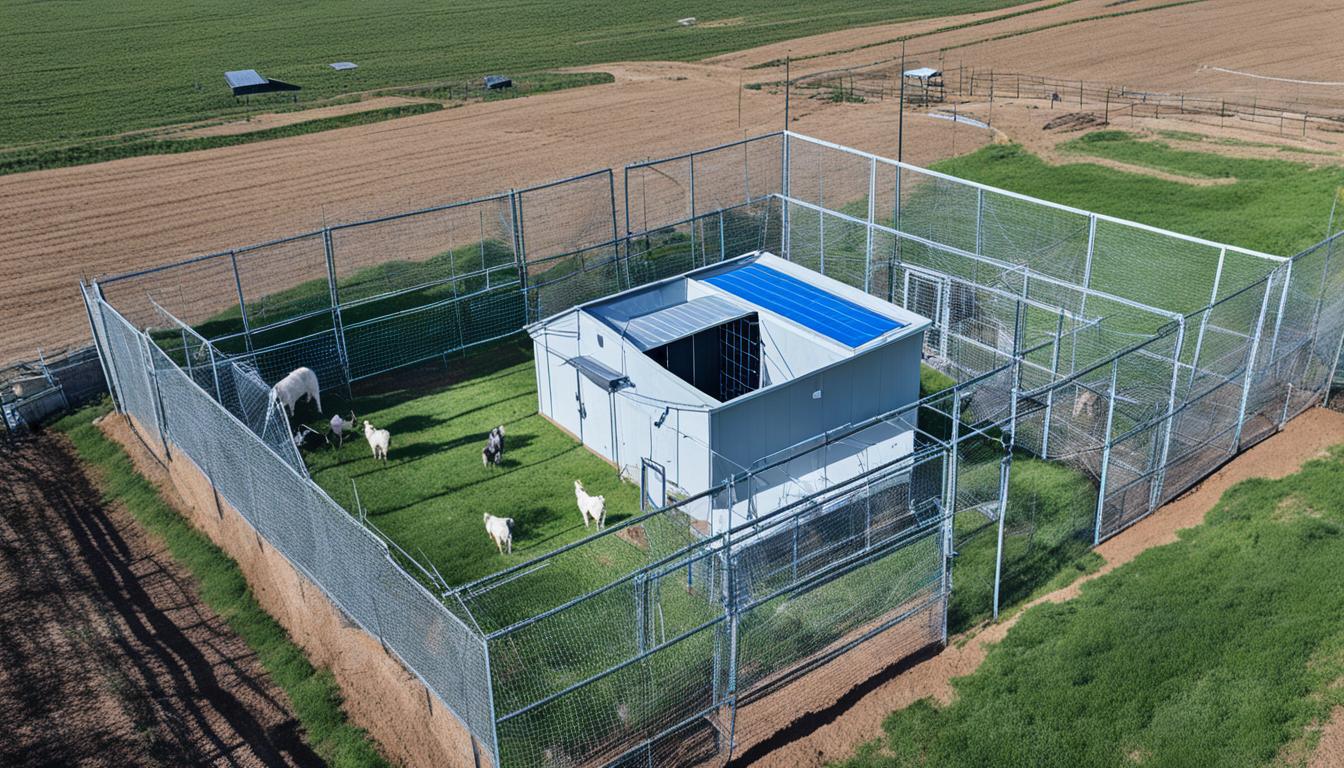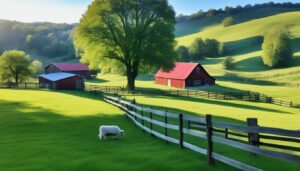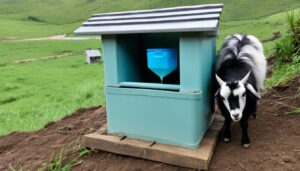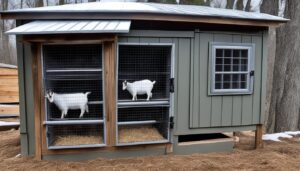On Christmas morning, I got a surprise that shocked me. It was the paperwork for two Nigerian Dwarf Dairy Goat doe kids. A close friend, Mr. Curbstone, had secretly arranged this gift a few weeks earlier. These goats will arrive on our farm in late February or early March. This news made us all thrilled!
Preparing the garden before the spring was tough. I wondered if having goats might have made the work easier. Yet, the dream of having fresh milk and cheese, and the fun of seeing goats play, excites us. We’ve admired others’ goats and even visited dairy goat shows to learn more.
Getting goats means we need to know more and work harder than with our chickens and turkeys. But, the idea of their happy company and their produce is too good to pass. Yet, we worry most about their safety. We must protect them from wild animals like coyotes and mountain lions. Building a safe barn and a secure outdoor area is a must.
Key Takeaways
- Securing a pygmy goat house from predators is crucial for their safety and well-being.
- Careful planning in the design and construction of the goat shelter is essential for long-term success.
- Selecting a secure location, reinforcing the structure, and incorporating predator-resistant fencing are key steps.
- Purchasing healthy, registered goats from a reputable breeder is important for a thriving herd.
- Providing proper nutrition and care, including bottle feeding for young kids, ensures the goats’ health and development.
Why We Decided to Get Goats
For a while, we’ve been eyeing the goats we see around. We’ve even been to goat shows without owning any yet. People might think we’re a bit off, but those shows are great for learning. You get to know so much about goats and even meet their breeders.
We were excited to add goats to our farm, but we took our time. I knew from before that they need more effort than our chickens or turkeys. It’s worth it, though, for the milk, the cheese, and the fun they bring to the farm.
Milk and Cheese Production
We’re really looking forward to the milk and cheese from our goats. We can’t wait to try our hand at making goat cheese. It’s going to be fun and tasty work.
Joy of Having Goats on the Farm
Having goats isn’t just about what they can give us. It’s also the joy they’ll bring to our days. They’re so lively, and watching them play is sure to make us happy.
Goatland Security Concerns
Our farm’s big worry isn’t just our chickens – it’s our goats. We live deep in the woods, and a lot of predators come by. Coyotes and bobcats are a common sight. There might even be mountain lions around.
Neighbors say they’ve seen them before. Loose domestic dogs are also a concern, given their hunting nature.
Predators in the Area
We’ve talked to some people who know about keeping goats in this area. They’ve recommended checking out the Mountain Lion Foundation. We’re thinking about getting a livestock guardian dog. But remember, even they might not always stop big predators. Plus, it takes time for a pup to grow up into an effective protector.
Secure Enclosures and Livestock Guardian Dogs
To safeguard our goats, we’re focusing on two key things. First, building a predator-proof barn. Second, creating a secure daytime enclosure. This is how we plan to keep our goats safe from the many dangers of the wild around our place.

Designing the Goat Barn
We planned a mini-barn for pygmy goats considering key factors. Since our land isn’t flat, we had to carefully plan its design. This was essential to fit the barn in our space. Also, goats dislike rain, and we get a lot of it from October to June. Keeping the barn dry was our main goal.
Terrain and Space Constraints
Our land is sloping and wooded, so barn placement was tricky. We used a concrete floor for strength and easy cleaning. The barn’s design maximized space. This ensured our goats not only had room to move inside but also in an outdoor yard.
Keeping the Barn Dry and Well-Ventilated
Milking goats in the rain is tough, so we focused on keeping their space dry. A well-ventilated area was important too. Good air is vital for our goats‘ health. Our goat barn has a special milking section and a main loafing stall area, which can be opened up to an outdoor yard.
Accommodating Future Goats and Kids
As our goat herd grows, we designed for more space and kids. We planned for additional stalls if needed. Our main goal is ample space for the goats both inside and outside. Yet, it ensures they’re protected from bad weather.
How Can I Predator-Proof a Pygmy Goat House?
Securing our pygmy goats is vital, starting with where and how we build their enclosure. Figuring out the perfect spot for our goat shed was the first hurdle. We faced a challenge since the land around us sloped and was covered in trees. We had to get creative to make a shed that would work on the uneven ground. In the end, we built it on a concrete floor. This choice was made for its strength, ability to stay dry, and how easy it is to keep clean.
Choosing a Secure Location
When building, we aimed to maximize space for the goats, indoors and out. We knew flexibility would be key to meeting the goats’ changing needs. Our design allows us to adjust the shed, even gating off space as needed. For instance, we can block the milking area to keep it dry when not used.
Reinforcing the Structure
Our shed not only had a strong foundation, but we also focused on making the whole thing sturdy. This ensures it’s hard for predators to get in. We used tough materials that can handle the wear of time and weather, plus keep predators out.
Predator-Resistant Fencing and Enclosures
Finally, we included predator-resistant fencing and secure areas to give our goats extra protection. These measures provide added safety, letting our pygmy goats freely wander and eat in their goat housing without worry.

Buying and Reserving Goats
We’re thrilled to bring pygmy goats to our farm. We’ve reserved two Nigerian Dwarf Dairy Goat doe kids from Red Rooster Ranch. This breeder ensures adult goats don’t have CAE, CL, and Johne’s diseases. They are also registered with the American Dairy Goat Association (ADGA). The kids come with the ADGA registration paperwork. We’ll handle the submission and any fees.
Health Testing and Registration
It’s vital for us to know our goats are healthy. The health testing and registration process at the ranch has given us peace of mind. We look forward to receiving the registration paperwork for our goats. This makes them a part of the farm officially.
Visiting the Farm and Purchasing Guidelines
We can’t visit Red Rooster Ranch before buying their goats. Yet, we can meet them for a 45-minute appointment to finalize our choice and get useful information. If we want to reserve a kid before it’s born, a $100 deposit is needed. For living kids or goats, we must pay 50% down.
Pricing and Discounts
The cost at Red Rooster Ranch is fair compared to others. Wethers are $250 to $450, while does and bucks are $550 to $700. They offer deals for 4-H, buying two bucks, and ADGA members. Registration and transfer fees are not charged to ADGA members. This is a great benefit.

Planning a Goat Ranching Business
Getting into goat farming takes thorough planning. You need to think about your goals and what you have to work with first. Then, consider your options like using goats for brush control or raising them for meat. Each way has rules to follow and things to aim for.
Different Types of Goat Operations
Finding the right match for your needs among the many types of goat farming is key. You might want goats for cleaning up the land, mixing them with other animals, competing in shows, or selling for meat. It’s important to know what each choice involves to make a smart decision.
Developing a Business Plan
Creating a goat business plan is essential for success. This plan lays out your mission, goals, and approaches. It also covers how you’ll manage the business, reach customers, and handle money. Having a solid business plan sets you up for doing well in the long run.
Enterprise Budgeting
A detailed financial plan is crucial for any goat business. It helps you see where your money will come from and go. Think about your space, money, skills, and how you’ll market your goats. This groundwork is vital for making a viable budget for your goat operation.

Goat Housing and Shelter Requirements
To raise healthy and active goats, you need a well-built goat housing and shelter. It’s crucial to think about the design and requirements. Some key points are:
- Goats need plenty of space because they’re lively and enjoy each other’s company.
- The shelter must be completely dry, free of drafts, and have good air circulation. This keeps their lungs healthy.
- Make sure there’s enough room for the whole group, plus space for growth and new baby goats.
- Include areas for eating and drinking, sleeping, and for goats that are feeling under the weather.
- Use strong, predator-proof materials to build the shelter.
- Put the shelter in a safe spot, far from any dangers.
It’s not just about their comfort. Meeting these goat housing requirements keeps goats safe and hardy. The design and building stages of their goat shelter are very important for success.

Feeding and Caring for Goats
Feeding goats right and caring for them properly are key to their well-being. Baby goats, or kids, drink fresh goat milk for the first three weeks. They also try eating alfalfa hay. After this, they start eating hay, drinking water, and taking goat minerals. Lactating does are the only ones that usually get grains. Remember, don’t feed them chicken feed; it’s harmful.
Nutritional Needs of Goats
A good diet for goats includes grain, hay, and minerals. Although they like treats like table scraps, avoid giving them cat or dog food, meat, or avocados. Correct nutrition is vital for their health.
Bottle Feeding Procedures
At Red Rooster Ranch, all baby goats are taught to drink from a bottle, starting at 10 days. They still stay close to their mothers during this. This bottle feeding not only helps their development but also builds a strong connection with their owners. Kids are weaned between 8 to 10 weeks before they move to new homes. Owners are given detailed instructions on feeding them from a bottle. This careful approach is crucial for their growth.

Conclusion
Introducing goats to our farm needs a smart plan, especially against predators in our woods. A predator-proof barn and daytime enclosure is crucial for keeping our pygmy goats safe and cozy. We should pick the right spot, make the structure stronger, and install predator-resistant fencing and features.
Getting healthy goats from a trusted breeder and feeding them well is key. This approach and care will help our pygmy goats not just survive but thrive on our farm.
The summary of predator-proofing a pygmy goat house and the key takeaways for securing goat housing are easy to understand. Prioritizing our goat’s safety and health can help us have a happy and productive herd. They’ll offer us milk, cheese, and lots of joy for years.
FAQ
How can I predator-proof a pygmy goat house?
To keep pygmy goats safe, find a secure place for their barn. Make sure the barn is strong. Use fences and enclosures that keep away predators, like coyotes and bobcats. A well-sealed barn, away from danger, made with tough materials is key.
What are the main predators in my area that I need to be concerned about?
In places with lots of trees, watch out for coyotes, bobcats, and mountain lions. Even free-roaming domestic dogs can pose a danger. Knowing what animals to look out for and how to keep them away is crucial for your goats’ safety.
How can I secure the goat enclosure against predators?
For a safe goat area, use strong fences. Woven wire or electric fences work well. Also, make sure their shelter locks at night. Having a guard dog can also help keep predators away.
What factors should I consider when designing the goat barn?
When putting together a barn for goats, think about the land. Make sure there’s enough room for a growing herd. A dry and well-ventilated space is important. Also, include spots for feeding, sleeping, and taking care of sick goats.
How do I purchase healthy, registered goats from a reputable breeder?
Look for breeders that check their goats for diseases. They should have registered goats, backed by the right documents. A good breeder will also share a lot of information about the goats, including their health and family background.
How do I properly care for and feed my new goats?
Keeping goats healthy means giving them the right food and care. Baby goats need fresh goat milk and hay. As they grow, they’ll eat hay, drink water, and have access to special minerals. Only mothers that are nursing are given grains.



